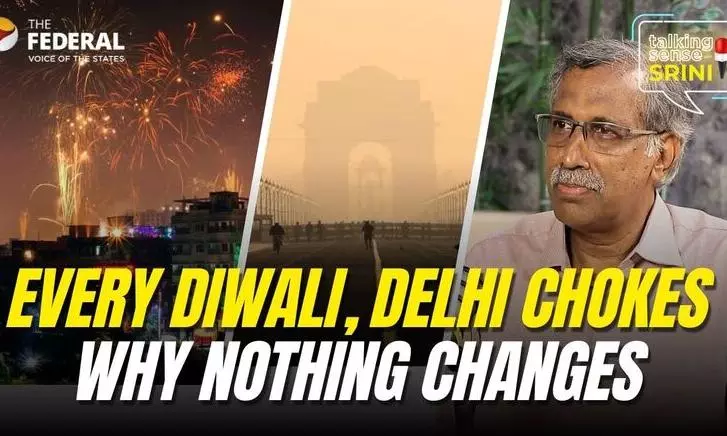
Srinivasan attributes Delhi’s pollution crisis to a lethal convergence of factors — meteorological, cultural, and political.
Every Diwali, Delhi chokes: Why nothing changes | Talking Sense With Srini
The Federal Editor-in-Chief S Srinivasan highlights the capital's annual suffocation, stating the city's air quality is equal to smoking 50 cigarettes a day, demands a blanket ban on crackers

A night of fireworks has left India’s capital gasping again. Within hours of Diwali celebrations, Delhi’s air quality index (AQI) soared to “hazardous” levels — turning the city into what S Srinivasan, Editor-in-Chief of The Federal, calls “no less than a gas chamber.”
Speaking on Talking Sense with Srini, he laid bare the grim reality of the capital’s annual post-Diwali suffocation.
“Each person in Delhi, including small children, nearly has an effect on their lungs equivalent to smoking 50 cigarettes a day,” Srinivasan said, citing a Delhi-based doctor who reported a 20 per cent rise in pulmonary cases immediately after Diwali. “It’s unlivable,” he admitted. “Living constantly in this environment actually reduces your lifespan considerably.”
Lethal convergence of factors
Srinivasan attributes Delhi’s pollution crisis to a lethal convergence of factors — meteorological, cultural, and political. As cold winds from the Thar Desert slow and trap pollutants over the capital, the region turns into a “box” of suspended toxins.
“With the fog descending, pollutants like sulfur dioxide, nitrogen oxide, and barium nitrate mix into a deadly cocktail we now call smog,” he explained.
Also Read: Delhi air pollution spikes post-Diwali: What is the way out? | Capital Beat
While vehicular emissions, industrial discharge, and waste mismanagement form the backdrop, stubble burning and firecrackers worsen the crisis each winter.
“Stubble burning adds another layer of pollution every year,” Srinivasan said. “This time, delayed monsoons and floods in Punjab have postponed farm fires, but the relief is temporary.”
Key culprit this time – cracker emissions
He noted that despite a 77 per cent reduction in farm fires in Punjab and Haryana this year, the city’s air has still worsened after Diwali — suggesting cracker emissions as the key culprit.
Also Read: After yet another toxic Diwali in Delhi, BJP blames stubble burning in AAP-led Punjab
He was critical of the Supreme Court’s decision allowing “green crackers,” noting they still cause 70 per cent of regular pollution.
“You don’t know whether those crackers were even green,” he said. “And enforcing a two-hour window for bursting crackers is impossible.”
Political inertia, blame games
Srinivasan believes the crisis persists because of political inertia and blame games.
“What else do you expect from politicians?” he asked. “They twist facts instead of thinking scientifically. Pollution control in Delhi needs an airshed approach — a coordinated plan across Delhi, Haryana, Punjab, and Uttar Pradesh. Air doesn’t stop at boundaries.”
Economic and human toll
The economic and human toll, he warned, is severe.
“There’s no difference between smokers and non-smokers in Delhi anymore. Even non-smokers are developing lung cancer,” he said. “The cognitive ability of children is falling, productivity is dropping, and healthcare costs are soaring. Yet pollution has never been an electoral issue in India.”
Also Read: Delhi’s air quality in ‘red zone’; residents flout SC’s time limit for firecrackers on Diwali
For a festival meant to celebrate light and renewal, Diwali has become, in Srinivasan’s words, “a festival of noise and pollution.”
His prescription is simple but politically tough: “a blanket ban on crackers and a holistic regional strategy.”
Until then, Delhiites will continue to breathe in the equivalent of “50 cigarettes a day” — one puff at a time.

